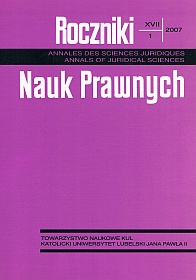Metody implementacji prawa wspólnotowego do systemów krajowych oraz zapewniania bezpośredniej skuteczności normom acquis na przykładzie Włoch, z uwzględnieniem autonomicznego statusu regionów
Abstrakt
Although the superiority and precedence of the communitarian law in legal orders of the member states is generally accepted from the systemic or structural perspectives, the implementation of the above principles is not uniform and unquestionable. This is due to the following: nearly every member state desires to retain as much sovereign power as possible, constitutions of the states specify the character of their legal systems, and the fact that the division of competences between the Communities and the member states is not always precise and clear-cut.
The judgements passed by some local constitutional tribunals are a manifestation of national particularism. The picture becomes even more blurred if the constituent parts of a given state (regions or states) have a greater legal autonomy. The case of Italy provides an interesting and instructive solutions (also in the context of Poland's problems in this area), where Article 11 of the Constitution is invoked to introduce the self-executability of the treaties via ordinary legislation, and to resolve problems posed by substantial autonomy of local self-governments, especially regional ones. Moreover, every year a framework law is enacted in order to harmonise and execute the acquis norms.
Bibliografia
Amalfitano C.: Dal ne bis in idem in diritto internazionale al ne bis in idem in diritto europeo, „Rivista del diritto internazionale privato” 2002, s. 932 n.
Brownlie I.: Principles of Public International Law, Oxford: Oxford University Press 20036.
Calamia A. M.: La nuova disciplina della concorrenza nel diritto comunitario, Milano: Giuffre Editore 2004.
Cassese A.: International Law, Oxford: Oxford University Press 2002.
Diritto dell'Unione Europea – Parte speciale, red. G. Strozzi, Torino: Giufre Ed. 2005.
Diritto Internazionale Pubblico, red. C. Caccaviello, E. Natale, A. Verrilli, Napoli: Ed. Simone 20067.
Emmert F., Morawiecki M.: Prawo europejskie, Warszawa–Wrocław: PWN 2002.
Galster J., Mik C.: Podstawy europejskiego prawa wspólnotowego. Zarys wykładu, Toruń: Comer 1996.
Il nouvo diritto della concorrenza. Aspetti procedurali, red. G. L. Tosato, L. Bellodi, Milano: Giuffre Ed. 2004.
Kenig-Witkowska M. M.: Charakter prawny Unii Europejskiej ze stanowiska prawa międzynarodowego. Uwagi na marginesie projektu Traktatu ustanawiającego Konstytucję dla Europy, [w:] Prawo polskie a prawo Unii Europejskiej. Konferencja Wydziału Prawa i Administracji UW, Warszawa 20.11.2003 r.
Kenig-Witkowska M. M.: Prawo instytucjonalne Unii Europejskiej, Warszawa: C. H. Beck 2004 (II wyd. – 2006).
Mik C.: Europejskie prawo wspólnotowe. Zagadnienia teorii i praktyki, t. I, Warszawa: C. H. Beck 2000.
Partecipazione dell'Italia alle fasi formativa ed applicativa del diritto comunitarioa, Roma: Senato della Repubblica 1991.
Poccar F.: Diritto dell'Unione e delle Comunità europeee, Milano: Giufre Ed. 2003.
Prawo Unii Europejskiej. Zagadnienia systemowe, red. J. Barcz, Warszawa: PiPG 2003.
„Rivista italiana di diritto pubblico comunitario”, roczniki 1995, 1996, 2002 i 2003.
Strozzi G.: Diritto dell'Unione Europea, Torino: Giufre Ed. 2005.
Tesauro G.: Diritto comunitario, Padova: Ed. CEDAM 20054.
The European Union as an Actor in International Relations, red. E. Cannizzaro, The Hague: Kluwer Law International 2002.
The European Union and International Legal Order. Discord or Harmony?, red. V.Kronnenberger The Hague–Boston–New York: Kluwer Law Int. 1998.
Trattato dell'Unione Europea e della Comunità Europea, red. A. Tizzano, Milano: Giuffre Ed. 2004.
Warda J.: Fundusze strukturalne Unii Europejskiej, Lublin: Verba 2005.
Wawrzyniak J.: Transformacja systemowa we Włoszech, [w:] Konstytucja igwarancje jej przestrzegania. Księga pamiątkowa ku czci prof. J. Zakrzewskiej, Warszawa 1996.
Zakrzewska J.: Ustrój polityczny Republiki Włoskiej, Warszawa: PWN 1986.
Copyright (c) 2007 Roczniki Nauk Prawnych

Utwór dostępny jest na licencji Creative Commons Uznanie autorstwa – Użycie niekomercyjne – Bez utworów zależnych 4.0 Międzynarodowe.


